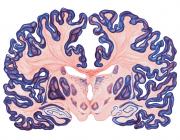Transient visual field defects induced by transcranial magnetic stimulation over human occipital pole.
Publication Year
1998
Type
Journal Article
Abstract
Transient visual field defects (VFDs) and phosphenes were induced in normal volunteers by means of transcranial magnetic stimulation (TMS) using a circular magnetic coil of 12.5 cm diameter placed with its lower rim 2-4 cm above the inion in the midline. Subjects had to detect small, bright dots presented randomly for 14 ms in one of 60 locations on a computer screen resulting in a plot of the central 9 degrees of the visual field. In 8 of 17 subjects, transient VFDs were inducible at peak magnetic field strenghts of 1.1-1.4 T. In the central 1-3 degrees, detection of targets was impaired in both the upper and lower visual field, whereas at 4-9 degrees large parts of only the lower visual field were affected with a sharp cut-off along the horizontal meridian. Targets at 1 degree in the lower field were affected with lower TMS intensities than corresponding locations in the upper or peripheral locations in the lower field. Detection of central targets was affected at more caudal stimulation sites than detection of peripheral targets. Phosphenes were elicitable in 14 of 17 subjects at clearly lower field strengths of 0.6-1.0 T. Many subjects perceived chromatophosphenes. From a discussion of the literature on patients with VFDs and the known topography of the human visual system, it is concluded that the transient VFDs at 1-3 degrees are probably due to stimulation of both striate cortex (V1) and extrastriate areas (V2/V3), while VFDs in the lower visual field at eccentricities 4-9 degrees are due to stimulation of V2/V3 but not V1.
Keywords
Journal
Exp Brain Res
Volume
118
Pages
19-26
Date Published
01/1998
ISSN Number
0014-4819
Alternate Journal
Exp Brain Res
PMID
9547074

